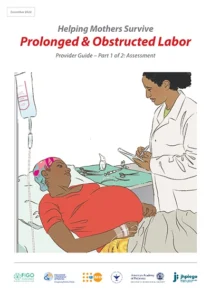Prolonged & Obstructed Labor
Reduce maternal and newborn deaths related to prolonged or obstructed labor.
Introduction
With this training, healthcare workers learn to assess, monitor, and support women whose labor is not progressing normally or who experience difficulties such as, abnormal presentation or position of the baby, ineffective contractions, and shoulder dystocia. The course is delivered in two parts —assessment and management.
Learning objectives
- Identifying the signs of potential complications
- Making time-critical decisions
- Communicating with the mother and the team
- Performing maneuvers to assist delivery of abnormal presentations such as breech position, and shoulder dystocia
- Managing ineffective contractions including administration of oxytocin
- Decision-making to seek advanced care
Duration
2 days, continuous or broken down to shorter sessions
Facilitator-to-participant ratio
1 facilitator for every group of 4 participants.
Learning materials
Download and preview the materials you will need. You should also have printed materials during a training. You can order printed materials from Laerdal, or download the printing files free of charge to print locally. To calculate how many copies you need, keep in mind that there should be one facilitator for every group of six participants.
These materials are copywrited and should not be altered. Contact us for inquiries about translations and adaptations.
Action Plan
A poster showing the steps to take during care, to use both during training and as a job aid for clinical practice.
1 per group (facilitator + 6 participants), and enough to leave at each facility to be used in clinical care.
Select an option
- Action PlanEnglish
- Action PlanFrench

Flip Charts
Paper-based facilitation tools, with guidance for facilitators to demonstrate, lead discussions and support practice.
1 set per group (facilitator + 6 participants)
Select an option
- Flip Chart 1French
- Flip Chart 1English
- Flip Chart 2English
- Flip Chart 2French

Provider Guide
A booklet for every healthcare worker to use during the training and keep afterwards. For reviewing content and practicing skills overtime.
1 set per participant
Select an option
- Provider Guide 1French
- Provider Guide 1English
- Provider Guide 2English
- Provider Guide 2French

-
Real birth videos by Global Health Media
Assessments
As part of the learning process, every training program includes assessments for the participants. You can download and print the assessments.
- Confidence Assessment
- Participant Characteristics
- Knowledge Check
- Knowledge Check Answer Key
- OSCE 1 RA prolonged labor
- OSCE 2 Evaluation for eligibility for oxytocin infusion
- OSCE 3 Shoulder dystocia
Looking for online LIFT assessments? Visit laerdal-lift.com
Equipment
Every group of 6 of participants will need these items to practice during the training. The equipment should also be available for practice in the facilities after the training.
- Birth simulator with newborn model that allows use of vacuum, we suggest MamaBirthie
- Pregnancy wheels or calendars
- Pens/pencils, paper, blank partographs and/or client records/labor documentation tool, referral forms
- BP machine – 1 per 2 learners
- Stethoscope – 1 per 2 learners
- Thermometer
- Gloves (clean and sterile)
- Fetoscope/Doppler and ultrasound gel
- Measuring tape
- Soap or alcohol based hand rub
- Towels, baby hat, and blanket
- Scissors or blade
- Hemostats, clamps, ties for cord
- Basin for placenta
- Personal protection for provider
- Mock oxytocin, misoprostol, ampicillin, gentamicin, betamimetics, rubbing alcohol, syringes and needles
- IV giving set., tourniquet, and fluids (normal saline, Ringer’s Lactate, 5% glucose)
- IV pump, if available
- Indwelling catheter with collection bag
- Suction device for newborn
- Ventilation bag and mask for newborn
- Clock/watch with second hand
- Gauze
Templates
Download and modify these documents to fit your needs when preparing and evaluating your course.
Package contains:
- Preparation Checklist 1
- Trainer Certificate
- Participant Course Agenda
- Participants Course Agenda
- Participant Certificate
- Participant Sign-in Sheet
- Practice Coordinator Evaluation
- Preparation Checklist
- Trainer Evaluation
- Participant Evaluation
- Master Trainer Certificate
- Practice Coordinator Certificate